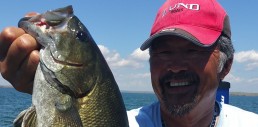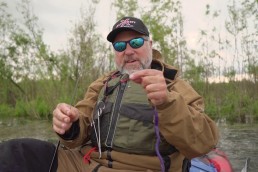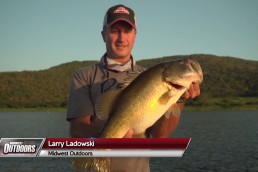Pursuit of Bass is Marathon Champ Beardsley’s New Race
SHARE THIS POST
Dick Beardsley can’t stop himself from running to Minnesota when bass season arrives.
Running comes naturally for the nationally known marathon runner, motivational speaker and fishing guide. When there’s bass to be caught, he runs faster yet.
“We will often catch 30 to 40 bass a day,” Beardsley says. “That’s not bad when you struggle sometimes to get a half dozen walleyes in the boat.”
Beardsley is a multi-species guide and has been fishing since his dad first introduced him to angling as a boy. By 14, he was guiding Lake Minnetonka from a 14-foot wooden boat with a 5-hp Mercury on the transom. Friends let him moor the boat at their dock because he was too young to drive it back and forth.
“My voice sounded like Mickey Mouse at the time,” Beardsley said, laughing. “Clients would phone and say they wanted to talk about a guide trip. I’d say, ‘Yeah.’ And they’d say, ‘Let me talk to your dad.’ Then I’d come back and say, ‘Dad doesn’t guide—I do’. I’d charge $20 or $25 a day so I thought I was in heaven getting paid for fishing.”
Never one to like most sports other than fishing, the once-bashful and extremely slender Beardsley launched himself into high school athletics in hopes of earning a letter jacket. He tried football first and says he only lasted a day.
It was then a friend told him about cross-country running.
“I’d never heard of it,” Beardsley said. “We ran a 3 1/2-mile course the first day; I had to walk the last mile.”
But he practiced the entire summer, running before his guide trips and afterward. The next year, he won that same race.
Beardsley eventually became a marathon runner, winning Grandma’s Marathon in 1981 and 1982. The record he set in 1981 for the course at 2 hours, 9 minutes and 36 seconds was still intact until in 2014 when it was finally broken. He devoted that same intensity to his guiding. By 16, he had saved enough money to buy 16-foot Lund guide boat and a 25-hp outboard.
Are you enjoying this post?
You can be among the first to get the latest info on where to go, what to use and how to use it!
Most clients wanted to fish for Minnesota’s favorite fish, the walleye. Over the years, Beardsley has been convincing more and more of them to try largemouths and smallmouths. Part of the reason he said centers on fishing shows that people watch in winter. Three-quarters of them feature the largemouths. Another reason is the “nature” of the species, as they fight hard and school up, so the action can be furious. And, this winter has been pretty mild in upper Minnesota so an early ice-out bodes well for early-season bass.
Beardsley uses similar tackle for both species. He prefers spinning gear because so many of his clients struggle with baitcasting equipment, and that’s just fine with him. Clear waters are prevalent in Minnesota, and often dictate finesse tactics. That’s why he spools up with 8- to 12-pound-test monofilament line, which is best used on spinning reels.
No matter which of the two species he’s after, the terminal tackle part is often the same: a light jig combined with a grub or a tube. If he would have to choose one color, chartreuse jigs would get the call.
Largemouths’ locations where they’re found are different from smallmouths.
For largemouth bass, Beardsley focuses on points and inside turns, which hold fish all year. The important factor is to find emerging weeds, and transition areas from hard to soft bottom are best. Try targeting the shallow water 3 to 5 feet deep. Fish both the outside and inside edges of the bed. Cast a 1/16-ounce jig and let it fall and pop it. He sometimes will drag the jig over the soft bottom to stir things up and attract attention.
Don’t overlook deeper water, even early in the season. Beardsley has caught largemouths on deep breaklines in 18 to 22 feet near boat docks. He rarely uses jigs heavier than 1/4 ounce, even at these depths. But if needed, he’ll step up to a 3/8-ounce jig if there’s trouble feeling the bottom due to that depth or any wind.
Beardsley doesn’t change much when he turns his attention to smallmouth bass; he uses the same setup and merely targets rocky shoreline points and the tips of gravel bars. Walleye anglers—does this sound familiar? It should. Also, he’ll often be fishing for walleyes and stumble into a school of smallies or fish for a smallmouth and catch a walleye.
And he usually isn’t too disappointed.
“Smallmouth bass are fun to catch. They fight hard and jump right out of the water.”
From his point of view, you just can’t run fast enough to get into fishing like that.
MWO
SHARE THIS POST
Did you enjoy this post?
You can be among the first to get the latest info on where to go, what to use and how to use it!
Ted Takasaki
Ted Takasaki is an International Fishing Hall of Fame professional angler who has been featured in many national outdoor magazines and television shows. Takasaki has appeared in front of thousands of angling enthusiasts and is considered one of America’s top walleye and multispecies anglers. Follow him on his Facebook page.



